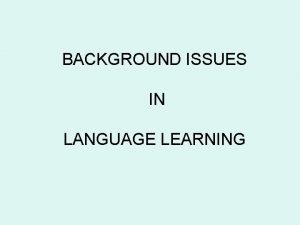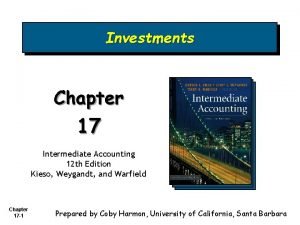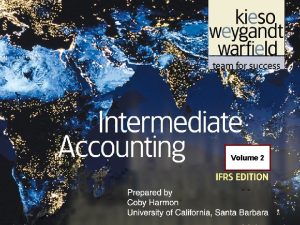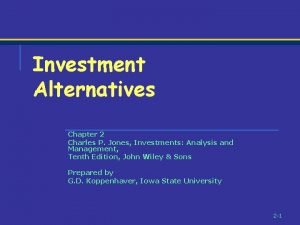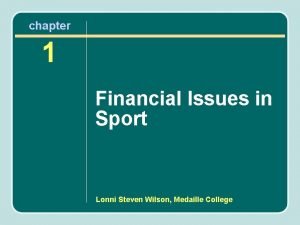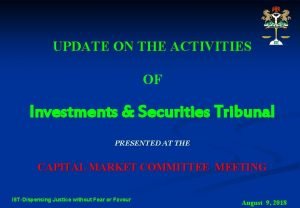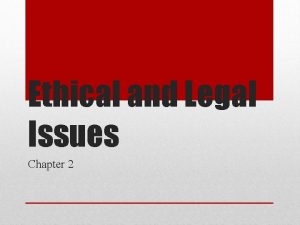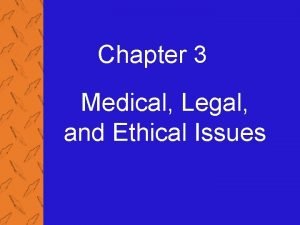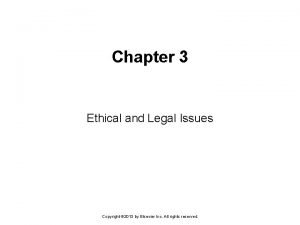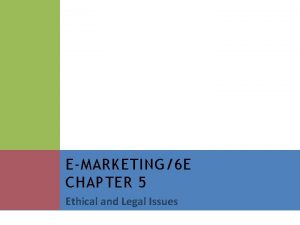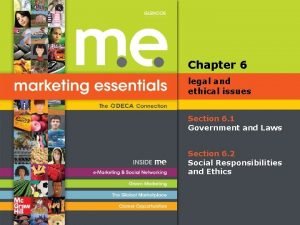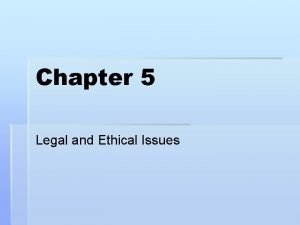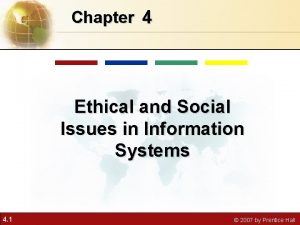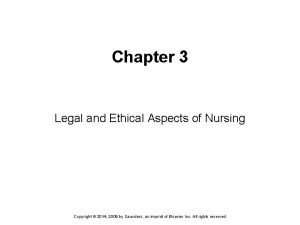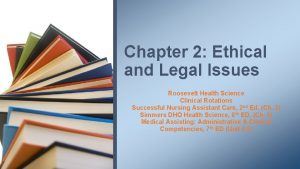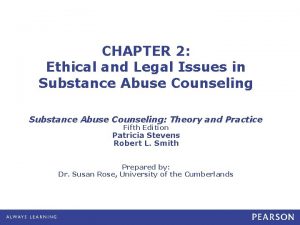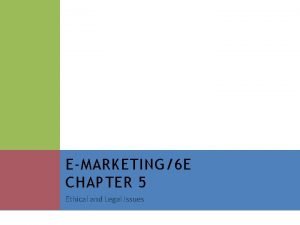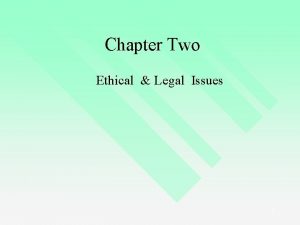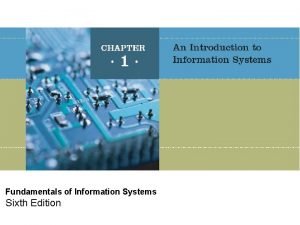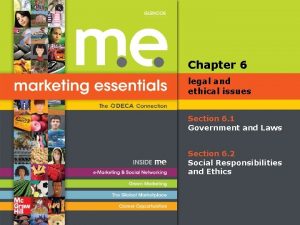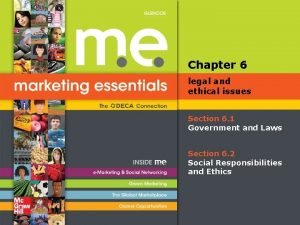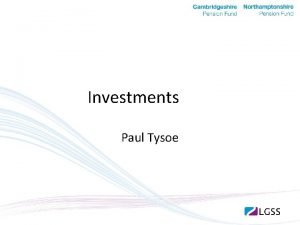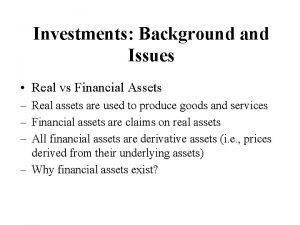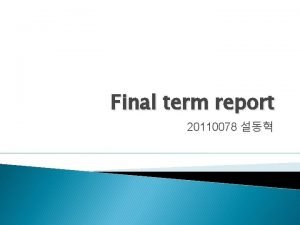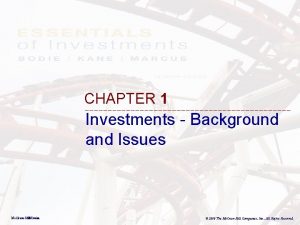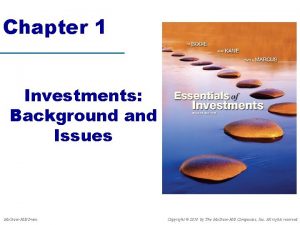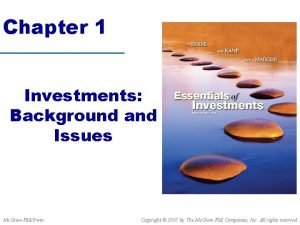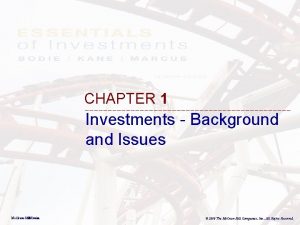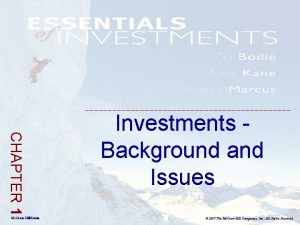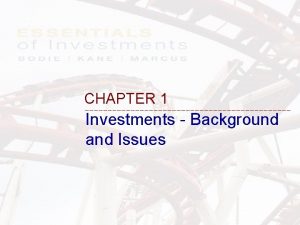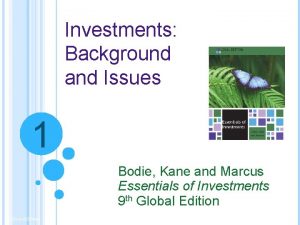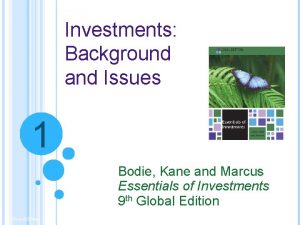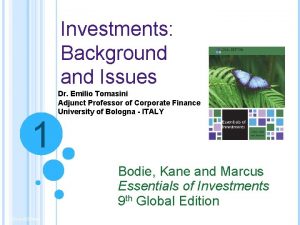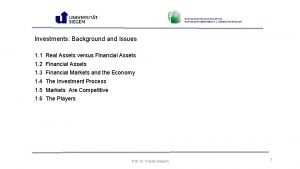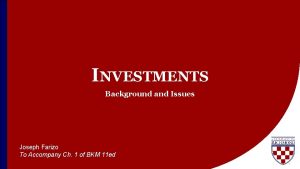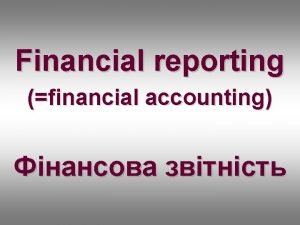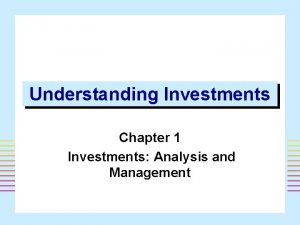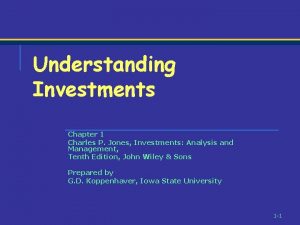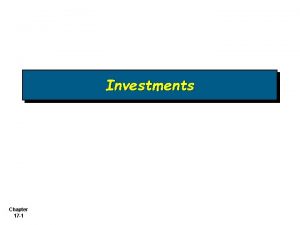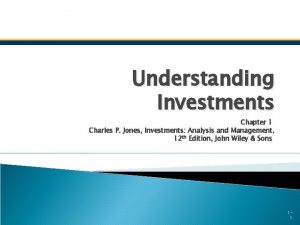Investments Background and issues CHAPTER 1 Investments Financial

Investments: Background and issues CHAPTER 1

Investments & Financial Assets n Essential nature of investment ¨ Reduced current consumption ¨ Planned later consumption n How to invest ¨ Real Assets: Assets used to produce goods and services n produce income to economy ¨ Financial Assets n Claims on real assets or income generated by them n Allocation of income, real assets among investors, individuals in the economy

Balance Sheet – U. S. Households

Financial Assets Financial assets Fixed-income (Bonds) Money Market (Short-term) Bond Market (Long-term) Equity (Stocks) Common Stocks Preferred Stocks Derivatives Options Futures

Role of Financial asset and financial markets in the Economy Consumption Timing n Allocation of Risk n Separation of Ownership and Management n

Consumption Timing Savers (earn more than spend) Financial assets: stocks, bonds, deposits, etc. Borrowers (spend more than earn) How do you transfer money from when you do not need to when you need?

Allocation of risk Example: GM wants to build a new auto plant, it raised money by issuing stocks and bonds Stock Auto plant High risk and low risk Stock investors (high risk) GM Bond investors (low risk)

Separation of ownership and management n n n Example: GE, total asset is $640 bil Cannot be single owner, must have many owners Selling stocks to market Currently, GE has 500, 000 owners These owners choose managers Can easily transfer ownership without any impact on management

The Investment Process Asset allocation n Security selection n Risk-return trade-off n Market efficiency n Active vs. passive management n

Investment process Small stock Stocks Big stock corporate bond Bonds Broad assets T-bond, T-bill Real estate House Land Commodity (1) Asset allocation coffee, tea gold, oil, etc (2) Security analysis

Example of Asset Allocation Age 30 s 40 s 50 s 60 s Common Stocks 70% 60 50 40 Bonds 30% 40 50 60

Example of Security Selection Your Stock Portfolio Auto Retail Wal-Mart Nordstroms Sears Financial Bank of America Berkshire Hathaway Citibank

There is no free lunch!

Market Efficiency n n n Security prices accurately reflect all relevant information. The price in the market is the true price Earn return just enough to compensate for risk, no abnormal return

Active vs. Passive Management Active Management n Finding undervalued securities n Timing the market Passive Management n No attempt to find undervalued securities n No attempt to time n Holding an efficient portfolio

Players in the Financial Markets Business Firms – net borrowers n Households – net savers n Governments – can be both borrowers and savers n Investment Bankers n

Players in the Financial Markets securities borrowers fund securities financial intermediaries borrowers savers borrowing rate lending rate securities Savers securities investment bank fund get commission fees savers

Recent Trends Globalization n Securitization n Financial Engineering n Computer Networks n

Globalization n In 1970, US equity market accounted for about 70 percent of equity in the world Currently, only 20 -30 percent How to invest globally Purchase ADRs ¨ Invest directly into international market ¨ Buy mutual fund shares that invest in international market ¨ derivative securities with payoff depends on prices of foreign market ¨

Securitization (1) more funds available to borrowers Banks (2) Transfer risk of loans to corresponding investors in the market pool all loans Mortgage loans auto loans credit card student loans other loans Benefits of securitization loans are securitized securities Investors High risk loan High risk securities High risk investors Low risk loan low risk securities low risk investors

Figure 1. 2 Asset-backed Securities Outstanding

Financial engineering n n n refer to creation of new securities Bundling: combine more than one security into a composite security Unbundling: breaking up and allocating the cash flows from one security to create several new securities

Building a Complex Security

Unbundling – Mortgage Security

Computer network Online trading fee is only $20, compared with brokerage firm $100. n Online information: cheap and available n automated trade crossing n ¨ example: if IBM price falls below $50, sell the stock automatically.

Summary Financial assets n Risk return tradeoff n Next class: Financial Securities n
- Slides: 26


